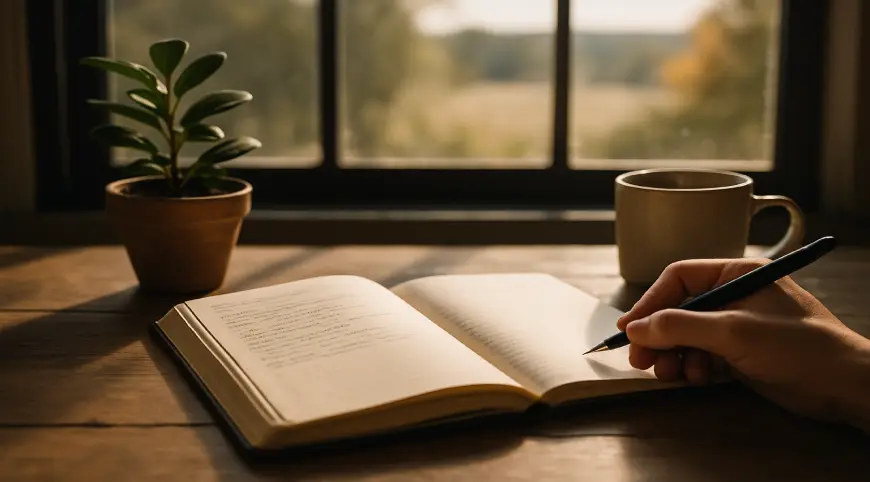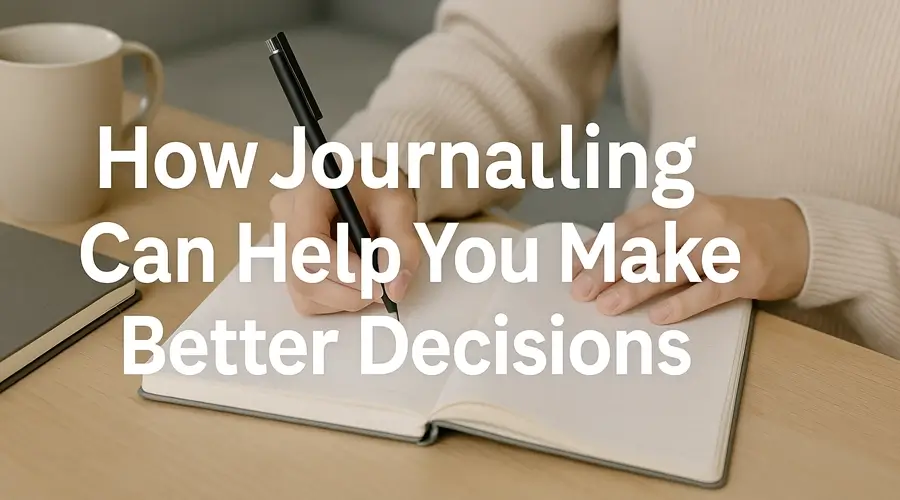When Your Mind Won’t Stay Still
You’re sipping your morning coffee, phone buzzing with messages, mind drifting between yesterday’s argument and tomorrow’s deadline. You want to feel here—calm, clear, grounded—but your thoughts keep sprinting elsewhere.
Sound familiar?
For many of us in our 20s, 30s, and even 40s, lack of focus, constant anxiety, and the exhausting tug-of-war between the past and future have become daily battles. We’re present in body, but our minds are scattered—everywhere but now. This mental chaos doesn’t just wear us out; it robs us of clarity, connection, and peace.
That’s where journaling for mindfulness comes in—not as a cure-all, but as a quiet, powerful tool to reclaim your attention.
At its core, mindfulness journaling is the practice of writing with full awareness. It’s not about storytelling or documentation—it’s about noticing. Through this simple, deliberate act, you invite your mind to settle, observe, and return to the now.
Why does it work?
Because writing slows you down. It gives your inner world a shape, a voice, a rhythm. With every sentence, you create space between thought and reaction. You become the observer of your thoughts, not their prisoner.
And that—however small it seems—is where real mindfulness begins.
In a world that glorifies speed, journaling for mindfulness is a gentle rebellion. It tells your nervous system: You’re safe. You’re here. You’re enough.
Let’s explore how a blank page can become your anchor to the present moment.
🌟 Ready to bring more mindfulness into your life? Start journaling today and discover the transformative power of mindfulness with Verbo. Visit Verboai to explore personalized journaling prompts and mindfulness tools. Download the app now and take the first step toward a more present and peaceful you! 🧘♀️📱
What Is Mindfulness Journaling?
Let’s be honest—most of us don’t need another productivity tool. We don’t need another box to tick off. What we need is a pause. A moment that’s ours.
That’s exactly what mindfulness journaling offers: a space to stop, breathe, and notice.
Unlike daily journaling, where you might write about what happened or how you felt, journaling for mindfulness isn’t about storytelling or emotional dumping. It’s about anchoring your awareness in the now—the only moment you actually have.
It’s not “Dear Diary, today was hard.”
It’s “I feel the weight of my body in this chair.”
It’s “My chest feels tight, and I don’t know why—but I’m noticing it.”
It’s “There’s birdsong outside my window. It sounds like presence.”
While emotional journaling explores feelings, and daily journaling captures memories, mindfulness journaling is more like meditation through words. You don’t chase thoughts—you observe them. You don’t plan—you pause. You don’t solve—you see.
It’s less about what happened and more about what’s happening right now.
It’s not linear. It doesn’t always make sense. And that’s the beauty of it.
In a world addicted to speed, journaling for mindfulness is a quiet act of rebellion. It slows you down. It says: “Hey, you’re here. You exist. This moment matters.”
And sometimes, that reminder is exactly what we need.

How Journaling for Mindfulness Helps You Stay Present
Let’s be honest—staying present sounds beautiful in theory, but in practice? It’s like holding water in your hands. One notification, one anxious thought, one memory, and suddenly—you’re gone. Your body is here, but your mind is elsewhere. That’s where journaling for mindfulness comes in. It’s not a miracle fix, but it is a powerful anchor.
1. Becoming Aware of Thoughts and Emotions
When you start journaling with intention—not to vent, not to organize, but simply to observe—something shifts. You begin to see your thoughts as passing clouds rather than absolute truths. Writing forces you to name what’s happening inside you:
“I feel tense.”
“I’m thinking about that awkward meeting again.”
“There’s a part of me that wants to avoid this feeling.”
By externalizing your thoughts and emotions, you stop being inside them. You become the observer—not the overwhelmed passenger. This self-awareness is the foundation of mindfulness.
2. Interrupting the Loop of Automatic Thinking
Ever catch yourself replaying a conversation from three days ago? Or worrying about a future that hasn’t arrived? That’s the autopilot mind doing its thing.
Journaling for mindfulness interrupts that loop.
When you put pen to paper and ask, “What’s really going on in my mind right now?” you create a pause. And in that pause, the loop weakens. Suddenly, your racing thoughts don’t feel as urgent. You gain perspective. You stop reacting and start noticing.
This is where the magic happens—when the page becomes a mirror, not a megaphone.
3. Reconnecting with Body and Surroundings
Mindfulness isn’t just about mental clarity—it’s also about embodiment. But most of us live from the neck up, disconnected from the sensory world around us.
Writing with presence brings you back to your senses. It helps you notice:
-
The tension in your shoulders
-
The coolness of the air
-
The texture of your pen gliding on paper
-
The background hum of the fridge
These small observations aren’t trivial—they’re doorways back to the moment. They remind you that you are here. That you’re breathing. That life is unfolding, not just in your thoughts, but in your body and your space.

📝 5 Proven Prompts to Cultivate Mindfulness Through Journaling
Sometimes, the hardest part of journaling for mindfulness is simply knowing where to begin. You sit with your notebook or your app open, and the silence feels louder than your thoughts.
That’s why prompts matter. They act like soft nudges—gently steering your awareness back to the present. These five carefully crafted questions are not about writing “well.” They’re about writing real.
1. “What do I hear, feel, and see right now?”
This question drops you straight into your senses. Not your story, not your schedule—your sensory reality.
Describe the hum of your fan, the slight ache in your shoulder, the light pouring through your window.
The more detail, the more grounded you become.
2. “What thought am I clinging to, and can I let it go?”
Notice the loop. That sticky thought that keeps popping up. Write it down—name it. Then ask: does it serve you?
You don’t have to force it away. Just gently release your grip and feel the space that opens up.
3. “How does my breath feel in this moment?”
Forget breathing exercises. Just notice. Is your breath shallow? Deep? Rushed? Easy?
Observing the breath with curiosity—not control—brings you back to the now, without needing to “fix” anything.
4. “What am I grateful for in this very second?”
Gratitude grounds you. And it doesn’t have to be big.
A warm mug. A good pen. The silence between noises.
Writing it down magnifies its presence in your life, even if it only lasts a few seconds.
5. “If I slow down, what do I notice?”
This prompt is like hitting “pause” on a busy mental playlist.
What arises when you don’t rush to fill the space? Maybe a tension you hadn’t noticed, or a moment of calm you rarely let in.
Let your pen be slow here—like your thoughts are walking, not sprinting.

Common Challenges (and How to Beat Them)
Let’s be real: the idea of sitting with your thoughts and writing them down sounds beautiful… until you actually try it. Then come the resistance, the excuses, and that awkward feeling of staring at a blank page like it owes you answers. Let’s unpack the most common challenges people face when starting journaling for mindfulness—and how to move through them with compassion and ease.
❓ “I don’t know what to write.”
This is by far the most common hesitation. You sit down, pen in hand, and your mind goes… fuzzy. No deep thoughts. No poetic insights. Just silence.
Why it happens:
You’re expecting your journal to be impressive or insightful from the get-go. But mindfulness journaling isn’t about writing something smart—it’s about writing something honest.
How to beat it:
-
Start with the obvious. Literally write: “I don’t know what to write.” And then: “But I’m feeling…tired/anxious/bored.”
-
Use a mindfulness prompt to get going. These are not tests—they’re doors.
-
Even describing your surroundings or what your breath feels like right now is enough. Your present moment is the content.
🎭 “I want it to sound complete, not raw.”
Many of us were raised on the idea that our writing must be polished. Neat. Ready for an audience. But mindfulness journaling has no reader—only a witness: you.
Why it happens:
You might feel vulnerable showing up as your unfiltered self. There’s a subconscious pressure to make your writing ‘make sense’ or offer closure.
How to beat it:
-
Remind yourself: This isn’t a novel. This isn’t for Instagram.
-
In fact, the more unfinished your thoughts feel, the more truthful they often are.
-
Give yourself permission to be incomplete, confused, contradictory. You’re not solving—you’re seeing.
🤫 “It’s too quiet… and it makes me uncomfortable.”
Silence can be confronting. The moment you unplug and slow down, everything you’ve been suppressing—thoughts, feelings, worries—bubbles up. Many people run from journaling not because they’re lazy, but because they’re afraid of what might surface.
Why it happens:
Stillness makes the noise inside louder at first. But this is exactly where mindfulness journaling works its quiet magic.
How to beat it:
-
Set a timer: Try 5 minutes. Promise yourself you can stop after.
-
Light a candle, play soft instrumental music, or pair journaling with tea. Make it a safe space.
-
Most importantly: stay. The discomfort is temporary, but the clarity it brings is powerful.
These challenges don’t mean you’re doing it wrong. They mean you’re showing up. That you’re choosing presence over perfection. And in a world that constantly tells you to rush, compare, distract, or improve… showing up is a radical act of mindfulness in itself.

🖋️ Digital vs. Paper: Which Is More Mindful?
When it comes to journaling for mindfulness, the medium you choose can deeply shape your experience. Should you reach for your favorite pen and a fresh notebook, or open a blank page in your notes app? Both options offer unique benefits—and the “right” choice often depends on your lifestyle, preferences, and even your emotional state.
📝 The Tactile Experience of Paper
There’s something grounding about putting pen to paper. The physical sensation of writing—the scratch of the nib, the weight of the notebook, the rhythm of your hand—slows you down, both mentally and physically. Writing by hand demands your attention. You can’t scroll. You can’t swipe. You’re here, in this moment, forming each letter with care.
Many people find that paper journaling enhances their sensory awareness. The texture, the smell of ink, even the way the page responds to pressure—these details pull you into the present. It’s not just writing; it’s a full-body experience. And in a world that often feels digital and disconnected, that grounded feeling can be incredibly therapeutic.
💻 The Flow and Flexibility of Typing
On the flip side, digital journaling offers speed, ease, and a certain kind of mental flow that handwriting can’t always keep up with. Typing lets you capture thoughts at the speed they come. For many, this feels liberating—especially if your brain tends to move fast and your handwriting can’t catch up.
Digital platforms also offer tools like password protection, cloud sync, tags, and searchability. You can create templates, set reminders, or even use voice-to-text when your hands are full. If convenience helps you journal more consistently, then digital might be your path to mindfulness.
And let’s be honest: sometimes you’re hit with a mindful moment when you’re on the train, in bed, or waiting in line. A notes app in your pocket can become your most accessible mindfulness tool.
🧭 Choose What Aligns With Your Life
So which one is more mindful—paper or digital? The answer isn’t either/or. It’s which one helps you stay present.
If the feel of pen and paper makes you pause and breathe deeper, lean into that. If typing lets you express yourself freely without judgment or delay, go with it.
This isn’t about aesthetics or rules. It’s about finding the format that supports your presence.
Your mindfulness journaling practice is deeply personal—so let your tools match your rhythm.

Building a Sustainable Mindfulness Journaling Habit
Creating a mindfulness journaling habit isn’t about writing pages every day or setting unrealistic expectations. It’s about weaving the practice into your life in a way that feels natural, nourishing—and doable.
Ritual vs. Routine: What’s the Difference?
A routine is what you do because you have to. A ritual is what you do because you want to.
When it comes to journaling for mindfulness, treat it like a ritual—an intentional pause in your day that signals: This moment is mine. Light a candle. Brew tea. Sit by the window. Even if it’s just for five minutes, the energy shifts when you treat it as something sacred instead of another to-do.
Routines are productive. Rituals are powerful.
How to Make It 5-Minute Friendly
Let’s be real: you’re busy. The good news? Mindfulness journaling isn’t about length—it’s about depth.
Here’s how to keep it short but meaningful:
- Set a timer for 5 minutes. When it rings, you’re done. No pressure to continue.
- Use simple prompts. (Like “What do I feel right now?” or “What’s one thing I noticed today that I usually overlook?”)
- Let go of structure. This isn’t an essay. Bullet points, messy grammar, even single words are enough.
- Keep your tools ready. A notebook on your desk or a note app on your phone makes it frictionless to begin.
Even five minutes of intentional presence can reset your nervous system. That’s the magic.
Anchor Your Practice to Everyday Moments
Want to make it stick? Attach journaling to an anchor moment—a habit you already do every day. When the anchor happens, it becomes your cue to write.
Examples:
☕ Coffee: While it brews, jot down how you’re feeling.
🛏 Bedtime: Reflect on one moment from the day that brought peace.
🚿 Post-shower: Tune into your senses and let words flow.
🧘 After meditation or breathwork: Capture what surfaced.
The goal isn’t to “fit journaling in”—it’s to gently fold it into what already exists in your day.
✨ In time, journaling won’t feel like another task. It will feel like a returning—to yourself.
And when done consistently, even in microdoses, it can transform not just your day—but your way of being.

📝 Conclusion
In this article, we explored how journaling for mindfulness is not just a writing practice—it’s a powerful way to return to the present moment.
We uncovered what makes mindfulness journaling different from regular journaling, how it helps you slow down and reconnect with your senses, and how even five minutes of honest reflection can create clarity, calm, and self-awareness.
Through mindful prompts, we learned how to gently shift from autopilot to awareness. And by treating journaling as a ritual (not a chore), anchoring it to small daily habits like coffee or bedtime, and removing pressure to be “perfect,” we saw how anyone—yes, even busy, distracted minds—can build a sustainable journaling habit.
Whether you write on paper or screen, in full sentences or scattered thoughts, the goal is presence—not polish.
You don’t need to be a writer. You just need to show up.
And with each word, you remind yourself: I am here. Now.


